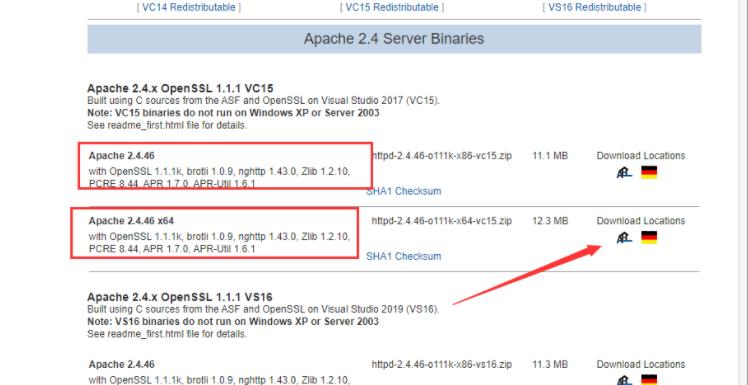
Apache Main Configuration File
The main configuration file configures Apache by placing instructions in a plain text configuration file. The main configuration file is usually a text file named: httpd.conf. The location of this file is set at compile time, but can be overridden using the -f command line flag. (Recommended learning: Apache Server)
In addition, you can use the Include directive to add other configuration files, and you can use wildcards to include many configuration files. Any directive can be placed in any of these configuration files. Only Apache will recognize changes to the main configuration file when it is started or restarted.
The server also reads files containing mime document types; the filename is set by the TypesConfig directive and defaults to mime.types.
Configuration file syntax
The Apache configuration file contains one directive per line. The backslash \ can be used as the last character on a line to indicate that the instruction continues to the next line. There can be no other characters or spaces between the backslash and the end of the line.
The directives in the configuration file are not case-sensitive, but the parameters of the directive are usually case-sensitive. Lines starting with the pound sign # are treated as comments and ignored. Comments may not be included on the same line as configuration directives. Whitespace appearing before a directive is ignored, so you can indent the directive for clarity. Empty lines are also ignored.
You can use the syntax ${ENVVAR} to use the value of the shell environment variable in the configuration file line. If "ENVVAR" is the name of a valid environment variable, the value of that variable is substituted at that location in the configuration file line, and processing continues as if that text were found directly in the configuration file. (If the ENVVAR variable is not found, the characters ${ENVVAR} remain unchanged for subsequent stages in configuration file processing.)
After environment variable substitution, concatenate any consecutive lines and remove leading and trailing The maximum length of a line in a configuration file with spaces is 8192 characters.
You can use apachectl configtest or the -t command line option to check syntax errors in the configuration file without starting the server.
Modularity
Apache is a modular server. This means that only the most basic functionality is included in the core server. Extended functionality is available through modules that can be loaded into Apache. By default, the server is compiled with a basic set of modules.
If the server is compiled to use dynamically loaded modules, you can compile the modules separately and add modules at any time using the LoadModule directive. Otherwise, Apache must be recompiled to add or remove modules. Configuration directives can be conditional on the inclusion of a specific module by enclosing them in an
To view the modules currently compiled into the server, you can use the -l command line option.
Scope of directives Directives placed in the main configuration file apply to the entire server. If you only want to change part of the server's configuration, you can place directives in the
These sections restrict the application of directives they contain to specific file system locations or URLs. They can also be nested, allowing very fine-grained configuration.
Apache can serve many different websites at the same time. This is called virtual hosting. Directives can also be scoped by placing them in the
Although most directives can be placed in any of these sections, some directives do not make sense in certain situations. For example, directives that control process creation can only be placed in the master server context. To find which directives can be placed in which sections, check the directive's context.
.htaccess file
Apache allows decentralized management of configuration through special files placed in the web tree. The special file is usually called .htaccess, but any name can be specified in the AccessFileName directive.
Directives placed in a .htaccess file apply to the directory where the file is placed and all subdirectories. .htaccess files follow the same syntax as the main configuration file. Since .htaccess files are read with every request, changes made to these .htaccess files take effect immediately.
To find directives that can be placed in a .htaccess file, check the context of the directive. Server administrators further control which directives can be placed in the .htaccess file by configuring the AllowOverride directive in the main configuration file.
The above is the detailed content of Introduction to the configuration file of the Apache server. For more information, please follow other related articles on the PHP Chinese website!
 Linux apache怎么限制并发连接和下载速度May 12, 2023 am 10:49 AM
Linux apache怎么限制并发连接和下载速度May 12, 2023 am 10:49 AMmod_limitipconn,这个是apache的一个非官方模块,根据同一个来源ip进行并发连接控制,bw_mod,它可以根据来源ip进行带宽限制,它们都是apache的第三方模块。1.下载:wgetwget2.安装#tar-zxvfmod_limitipconn-0.22.tar.gz#cdmod_limitipconn-0.22#vimakefile修改:apxs=“/usr/local/apache2/bin/apxs”#这里是自己apache的apxs路径,加载模块或者#/usr/lo
 图文详解apache2.4+php8.0的安装配置方法Dec 06, 2022 pm 04:53 PM
图文详解apache2.4+php8.0的安装配置方法Dec 06, 2022 pm 04:53 PM本文给大家介绍如何安装apache2.4,以及如何配置php8.0,文中附有图文详细步骤,下面就带大家一起看看怎么安装配置apache2.4+php8.0吧~
 apache版本怎么查看?Jun 14, 2019 pm 02:40 PM
apache版本怎么查看?Jun 14, 2019 pm 02:40 PM查看apache版本的步骤:1、进入cmd命令窗口;2、使用cd命令切换到Apache的bin目录下,语法“cd bin目录路径”;3、执行“httpd -v”命令来查询版本信息,在输出结果中即可查看apache版本号。
 nginx,tomcat,apache的区别是什么May 15, 2023 pm 01:40 PM
nginx,tomcat,apache的区别是什么May 15, 2023 pm 01:40 PM1.Nginx和tomcat的区别nginx常用做静态内容服务和代理服务器,直接外来请求转发给后面的应用服务器(tomcat,Django等),tomcat更多用来做一个应用容器,让javawebapp泡在里面的东西。严格意义上来讲,Apache和nginx应该叫做HTTPServer,而tomcat是一个ApplicationServer是一个Servlet/JSO应用的容器。客户端通过HTTPServer访问服务器上存储的资源(HTML文件,图片文件等),HTTPServer是中只是把服务器
 超细!Ubuntu20.04安装Apache+PHP8环境Mar 21, 2023 pm 03:26 PM
超细!Ubuntu20.04安装Apache+PHP8环境Mar 21, 2023 pm 03:26 PM本篇文章给大家带来了关于PHP的相关知识,其中主要跟大家分享在Ubuntu20.04 LTS环境下安装Apache的全过程,并且针对其中可能出现的一些坑也会提供解决方案,感兴趣的朋友下面一起来看一下吧,希望对大家有帮助。
 php站用iis乱码而apache没事怎么解决Mar 23, 2023 pm 02:48 PM
php站用iis乱码而apache没事怎么解决Mar 23, 2023 pm 02:48 PM在使用 PHP 进行网站开发时,你可能会遇到字符编码问题。特别是在使用不同的 Web 服务器时,会发现 IIS 和 Apache 处理字符编码的方法不同。当你使用 IIS 时,可能会发现在使用 UTF-8 编码时出现了乱码现象;而在使用 Apache 时,一切正常,没有出现任何问题。这种情况应该怎么解决呢?
 如何在 RHEL 9/8 上设置高可用性 Apache(HTTP)集群Jun 09, 2023 pm 06:20 PM
如何在 RHEL 9/8 上设置高可用性 Apache(HTTP)集群Jun 09, 2023 pm 06:20 PMPacemaker是适用于类Linux操作系统的高可用性集群软件。Pacemaker被称为“集群资源管理器”,它通过在集群节点之间进行资源故障转移来提供集群资源的最大可用性。Pacemaker使用Corosync进行集群组件之间的心跳和内部通信,Corosync还负责集群中的投票选举(Quorum)。先决条件在我们开始之前,请确保你拥有以下内容:两台RHEL9/8服务器RedHat订阅或本地配置的仓库通过SSH访问两台服务器root或sudo权限互联网连接实验室详情:服务器1:node1.exa
 Linux下如何查看nginx、apache、mysql和php的编译参数May 14, 2023 pm 10:22 PM
Linux下如何查看nginx、apache、mysql和php的编译参数May 14, 2023 pm 10:22 PM快速查看服务器软件的编译参数:1、nginx编译参数:your_nginx_dir/sbin/nginx-v2、apache编译参数:catyour_apache_dir/build/config.nice3、php编译参数:your_php_dir/bin/php-i|grepconfigure4、mysql编译参数:catyour_mysql_dir/bin/mysqlbug|grepconfigure以下是完整的实操例子:查看获取nginx的编译参数:[root@www~]#/usr/lo


Hot AI Tools

Undresser.AI Undress
AI-powered app for creating realistic nude photos

AI Clothes Remover
Online AI tool for removing clothes from photos.

Undress AI Tool
Undress images for free

Clothoff.io
AI clothes remover

AI Hentai Generator
Generate AI Hentai for free.

Hot Article

Hot Tools

SublimeText3 English version
Recommended: Win version, supports code prompts!

SAP NetWeaver Server Adapter for Eclipse
Integrate Eclipse with SAP NetWeaver application server.

WebStorm Mac version
Useful JavaScript development tools

SublimeText3 Linux new version
SublimeText3 Linux latest version

MinGW - Minimalist GNU for Windows
This project is in the process of being migrated to osdn.net/projects/mingw, you can continue to follow us there. MinGW: A native Windows port of the GNU Compiler Collection (GCC), freely distributable import libraries and header files for building native Windows applications; includes extensions to the MSVC runtime to support C99 functionality. All MinGW software can run on 64-bit Windows platforms.






